
Fan / Light Combination Fixture Switch Circuits
Fan Always Hot / Light Switched
3 way Switches Power at Fixture – routed thru the Ceiling box between Switches
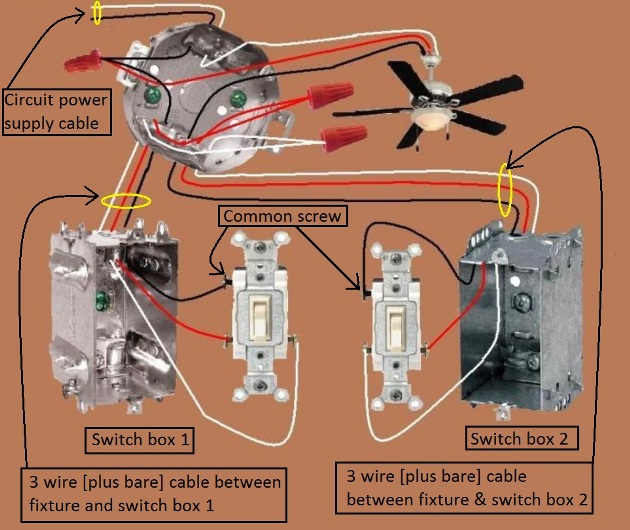
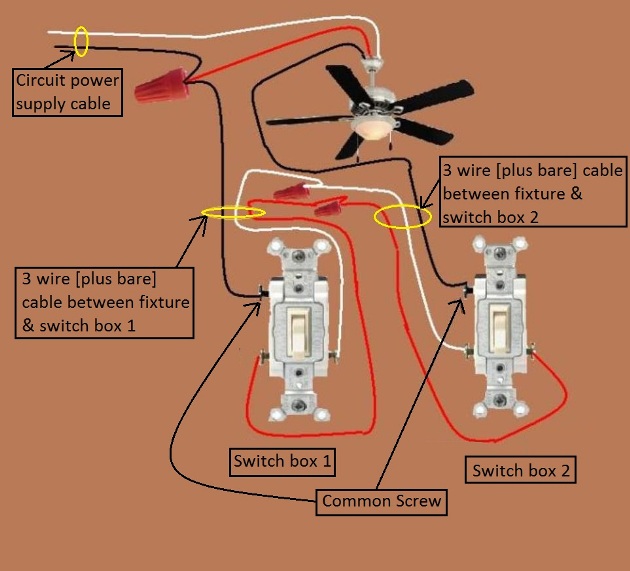
Connections Instructions:
(as depicted in the diagrams above)
At the Fixture box…
Three cables entering this box, which is the ‘circuit power supply cable’, the wire cable between fixture & switch 1, and the wire cable between fixture and switch 2.
- a) using an insulated wire nut connect / join the black wire coming from the ‘circuit power supply cable’ + the black wire coming from switch 1 + the ungrounded conductor (hot) of fan (shown as red in diagram).
- b) connect the black wire coming from switch 2 to the switched ungrounded conductor (hot) from light (shown as black in diagram)
- c) connect the white wire from the ‘circuit power supply cable’ to the grounded conductor (neutral) of fixture.
- d) using an insulated wire nut connect / connect the white wire from switch 1 + the white wire from switch 2.
- e) using an insulated wire nut connect / connect the red wire from switch 1 + the red wire from switch 2.
- f) please see under important notes in regards to the equipment grounding conductor (bare wire).
At switch box 1…
One cable entering this box coming from fixture.
- a) connect the black wire coming from fixture to the common screw of the 3 way switch (this will switch the light of the fan/light combo fixture)
- b) connect the red wire coming from fixture to one of the remaining main screws of 3 way switch.
- c) connect the white wire from fixture to the last remaining main screw of 3 way switch.
- d) please see under important notes in regards to the equipment grounding conductor (bare wire).
At switch box 2…
One cable entering this box coming from fixture.
- a) connect the black wire coming from fixture to the common screw of the 3 way switch (this will switch the light of the fan/light combo fixture)
- b) connect the red wire coming from fixture to one of the remaining main screws of 3 way switch.
- c) connect the white wire from fixture to the last remaining main screw of 3 way switch.
- d) please see under important notes in regards to the equipment grounding conductor (bare wire).
Important Notes:
By electrical codes you MUST have at least 6 inches of wire in the electrical box itself, and also the wire must be able to reach at least 3 inches outside the box, it can fail an electrical inspection if the required min. wire length is not met. You may have the wires a bit longer (within reason) but they cannot be shorter. Also see the note on box fill further down in this article.
You are allowed to re-designate a white wire to be used as a hot (ungrounded conductor) in switch circuits but in those cases where a white wire is used in this manner, you must wrap a piece of black electrical tape around that white wire inside the box to signify that is being used as an ungrounded (hot) conductor.
You cannot re-designate a white wire that is actually connected to the light fixture itself. At the fixture itself, the white wire must be the grounded conductor (neutral) coming from the circuit power supply cable.
In the configuration depicted on this page, the white wire coming from switch 1 to fixture and the white wire coming from switch 2 to fixture has been re-designated as a switched ungrounded conductor (hot) and therefore requires a piece of black electrical tape around both end of this wire; the white wire at fixture from the ‘circuit power supply cable’ that connected to the grounded conductor of fixture has not been re-designated and therefore NO black tape on the ends of that wire.
Use wire nuts of the correct size to join wires together. For fan / light combination fixtures, most likely it will have wire connections, the white wire is the grounded conductor (neutral), any green wires are equipment grounding conductors, then there will be two other wires one will be the switched ungrounded conductor (hot) for the light, and one will be the ungrounded conductor (hot) for the fan. If you are confused please post to our forums for further clarification.
What is not shown in the drawings to avoid confusion, is that each wire cable also has a bare equipment grounding wire included. This wire is connected to a grounding screw in each electrical box (if the box is metal), joined either through the grounding screws in the box itself or via a wire nut to the bare wire of the next cable entering / exiting the box, it is also connected to any grounding screw (if there is one) on the switch itself, as well as any grounding screw at the fixture (green wires that attach to the fixture are grounds). Now if using a plastic box, it is made of a material that is non conductive, however some plastic boxes have a metal strip inside that can still be used to connect equipment grounding wires, in the event that it does not use wire nuts to join the bare grounding wires together. The equipment grounding wire (bare in most cables) must be electrical conductively joined throughout the circuit. Green wires are also equipment grounding conductors.
At the switch itself there are 3 main electrical screws, one of these 3 screws is distinctly different in color (perhaps darker) than the other 2. This screw connection is called the common screw. It is very important that in order for the 2 switches to work as they are intended to that the correct wire is attached to the common screw. Basically as depicted in the drawings one switch has the ungrounded conductor (hot) from the circuit power supply cable attached to the common screw, where the other switch had the ungrounded conductor (hot) feed to the light fixture itself.
Please also note that there are a variety of manufactures out there that make 3 way switches so it is possible that the switch you buy may have the common screw located in a different spot or side of the switch then depicted in the drawings in this article, just make sure that the wire depicted to go to the common screw of each of the switches is actually connected to the common screw of the 3 way switch you bought. The other 2 wires going between the remaining screws of one switch to the other switch does not matter as long as one wire of the 2 remaining wires go on each of the remaining 2 screws of the screw.
If there is an equipment grounding screw on the switch it may be green in color and be separated away from the main connections of the switch and likely part of the metal frame that is also part of the mounting structure of the switch.
Extensions to this Switch circuit…
Be Aware that there is a limit by code on how many wires can be in a given size electrical box, when adding more wires to the same box you may have to install a larger and / or deeper box to allow space for more wires coming and out of the box.
Here is an article / explanation in regards to box fill calculations ‘Box Fill Calculation’
The instructions here are based on the fact that the circuit has already been wired to the configuration shown in this article and we are now making the wiring changes for onward power.
From the switch locations….
(No onward power is available from either switch locations because a grounded conductor [neutral] is not available at these locations.
From the fixture location….
(both always on and switched power is available from the fixture location)
(showing bellow the fixture portion of the circuit)
Option 1 – Onward switched power…
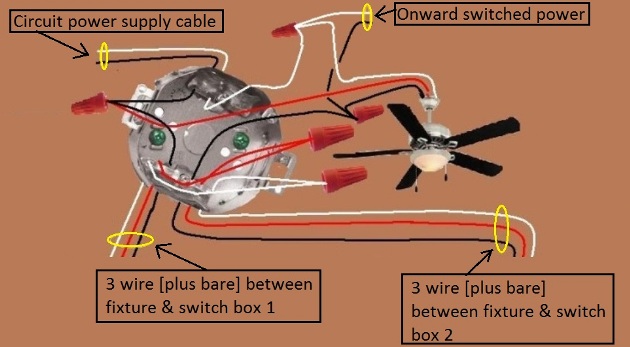
Not shown in the diagram but the onward cable also has a bare wire (equipment grounding conductor) that also must be connected to all the other bare wires at the fixture electrical box.
Connection Instructions for onward cable (switched)
(only the changes to the wiring are described here)
- a) Using an insulated wire nut, attach / join – the white wire of onward cable + the white wire coming from the ‘circuit power supply cable’ + the grounded conductor (neutral) from fixture (shown as white in diagram).
- b) Using an insulated wire nut, attach / join – the black wire of onward cable + the black wire from switch 2 + the switched ungrounded conductor (hot) of light (shown as black in diagram)
Identification of wires of onward wire cable…
Black – switched ungrounded conductor (hot – switched).
White – grounded conductor (neutral).
Option 2 – Onward ‘always on’ power…
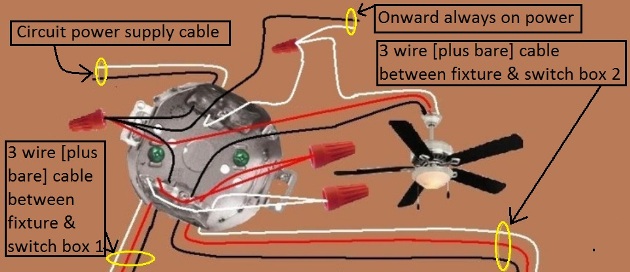
Not shown in the diagram but the onward cable also has a bare wire (equipment grounding conductor) that also must be connected to all the other bare wires at the fixture electrical box.
Connection Instructions for onward cable (always on)
(only the changes to the wiring are described here)
- a) Using an insulated wire nut, attach / join – the white wire of onward cable + the white wire coming from the ‘circuit power supply’ cable + the grounded conductor (neutral) from fixture (shown as white in diagram).
- b) Using an insulated wire nut, attach / join – the black wire of onward cable + the black wire from switch 1 + the ungrounded conductor (hot) of fan (shown as red in diagram) + the black from circuit power supply cable.
Identification of wires of onward wire cable…
Black – ungrounded conductor (hot – always on).
White – grounded conductor (neutral).
Option 3 – Onward switched & ‘always on’ power…
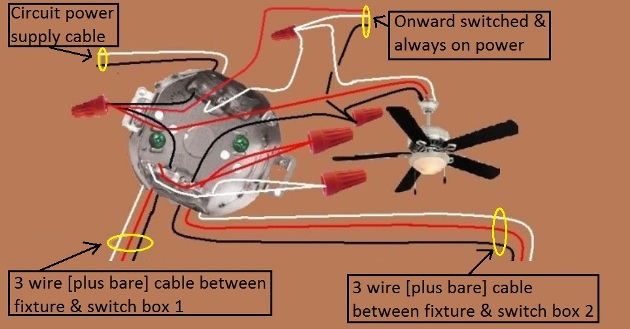
Not shown in the diagram but the onward cable also has a bare wire (equipment grounding conductor) that also must be connected to all the other bare wires at the fixture electrical box.
Connection Instructions for onward cable (always on & switched)
(only the changes to the wiring are described here)
- a) Using an insulated wire nut, attach / join – the white wire of onward cable + the white wire coming from the ‘circuit power supply’ cable + the grounded conductor (neutral) from fixture (shown as white in diagram)
- b) Using an insulated wire nut, attach / join – the black wire of onward cable + the black wire coming from switch 2 + the switched ungrounded conductor (hot) connected to light of fixture (shown as black in diagram).
- c) Using an insulated wire nut, attach / join – the red wire of onward cable + the black wire from the ‘circuit power supply’ cable + the ungrounded conductor (hot) connected to fan of fixture (shown as red in diagram) + the black wire coming from switch 1.
Identification of wires of onward wire cable…
Red – ungrounded conductor (hot – always on).
Black – switched ungrounded conductor (hot – controlled from switch)
White – grounded conductor (neutral).
Foreign Users:
The colors of the wires depicted are based on the standards and code requirements / configuration in the United States and Canada. If you are viewing this site from a foreign country, your wiring standards and color of wires may be different but the principal and sequence of wiring will still remain the same. Therefore the information in this article may still be of use to you regardless of what country you may be in. Just translate the colors used here to the color of wires used in your country in regards to ungrounded (hot) conductors / grounded conductors (neutral) and equipment grounding conductors as well know applicable code requirements in your country
WHILE EXTREME CARE HAS BEEN IMPLEMENTED IN THE PREPARATION OF THIS SELF-HELP DOCUMENT, THE AUTHOR AND/OR PROVIDERS OF THIS DOCUMENT ASSUMES NO RESPONSIBILITY FOR ERRORS OR OMISSIONS, NOR IS ANY LIABILITY ASSUMED FROM THE USE OF THE INFORMATION, CONTAINED IN THIS DOCUMENT, BY THE AUTHOR and / OR PROVIDER
By: Donald Kerr